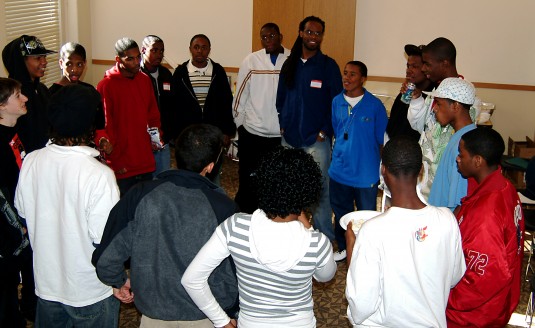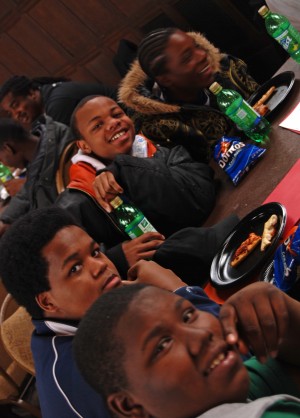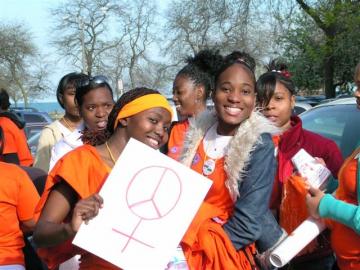Young Men as Allies to End Violence against Women and Girls
By the Rogers Park Young Women’s Action Team
Since June 2006, the Young Women’s Action Team (YWAT) has been immersed in a multi-part campaign called “Engaging Young Men as Allies to End Violence against Women and Girls.” One of the most important aspects of our project is the research that we have undertaken to better understand how young men perceive issues of violence against women and girls.
The first part of our research involved producing a documentary called “Real Talk” in collaboration with Beyondmedia Education (www.beyondmedia.org). For this, we wanted to primarily get the perspectives of the young men in our community. We relied on friends and acquaintances. We also interviewed some local experts – adult men who we admire. We spent several days crafting our interview questions. We felt good about the final product but knew that it was still limited in its scope. Because we mainly reached out to people from our community and social circles, the interviewees were primarily African American and White. We did not hear the voices of Latino and Asian young men in the film.
It was important to us that our documentary included the voices of young women who have been personally impacted by male violence. As such, the male voices in the film shared the screen with those of young women. We were the ones narrating the story in the documentary. It provided a window through which we were introduced to what some men thought and how they felt about violence against women and girls.
We considered the documentary as the first phase of our research. In phase two, we decided that we wanted to let young men speak for themselves. A small group of us developed a survey that we decided to administer to young men ages 12-24. The survey covered some questions that we didn’t ask in the film and others that could help us plan ahead for the next phases of our project. A primary reason for developing the survey was to capture the voices of Latino and Asian young men along with those of African Americans and Whites.
We were helped by our male ally and classmate, Brandon Carter, who collected over 45 surveys from young men. In addition, Nick Gainer from Between Friends who is also an ally collected over 120 surveys for us. We thank them for their help and consistent support. In total, we collected 226 surveys from young men ages 12-22.
The following is a summary of our key findings from the survey:
- 58% of young men surveyed said that issues of violence against women and girls are very important to them. Only 3.6% said that these issues were not important to them.
- 50.9% of our respondents said that between 1 and 5 of their male friends or family members would be interested in getting involved in taking action on issues of violence against women and girls.
- 64.2% of young men surveyed have ever asked someone to stop using derogatory or negative terms to refer to girls and women (i.e. slut, ho, bitch).
- Over half of our respondents (52.7%) said that they had intervened during a physical confrontation between a boy and girl.
- Most of the young men (56.6%) who were surveyed personally knew between 1 to 5 girls and women who have experienced male violence.
- The majority of respondents (52.2%) said that 1 to 5 male friends or family members would suggest that women provoke the violence that they experience at the hands of men.
- We asked the young men surveyed why they thought that more men are not involved in working to end violence against women and girls. Their answers listed below were very encouraging and provide an entry point for recruiting more men to the movement to end male violence against women.
| Not important/not our issue | 28.9% |
| Not enough time | 7.6% |
| Never asked to be involved | 23.1% |
| Don’t know enough about the issues | 40.4% |
- Only 18.2% of our survey respondents have considered joining or working with organizations that actively confront sexism and take steps to prevent violence against women and girls.
Practical Applications
As we moved ahead to develop our train the trainer session for male allies on November 2nd and 3rd 2007, we worked with our ally Ed Mills and used some of what we learned in our survey research to inform our work.
A. Accentuate the positives – Build from Strength.
- Violence against Women and Girls IS a Men’s Issue — We plan to highlight the fact that the overwhelming majority of young men say that issues of violence against women and girls are important to them. We will lead with this in order to establish a foundation from which to build together.
- Many young men say that they have acted in some way to interrupt interpersonal violence. We need to lift up these stories and invite workshop participants to share their own stories of resisting the role of silent bystander.
B. Provide concrete examples preferably through visual or auditory resources of men who publicly denounce violence against women and girls and other forms of violence.
- Our findings suggest that young men are not quite ready to step into public roles in the anti-violence against women and girls movement. This raises at least three questions for us at this time.
- What other roles should we be asking them to play in the movement?
- Is it enough if young men remain at the level of taking individual responsibility for interrupting interpersonal violence?
- What are the specific, culturally-relevant resources that exist or can be created to provide examples of the public role that other men have taken in the anti-violence movement (in general)? These could be used and perhaps adapted for our work.
C . Personalize stories of violence against women and girls.
- Our findings confirm that most young men personally know at least one woman or girl who has been victimized by male violence.
- We will appeal to this reality and ask them to share a personal story about a girl or woman who they know has been a victim of violence.
- We will use this as an entry point before discussing the broader framework of oppression.
Anyone who is interested can download a detailed copy of our research in the resources section.



